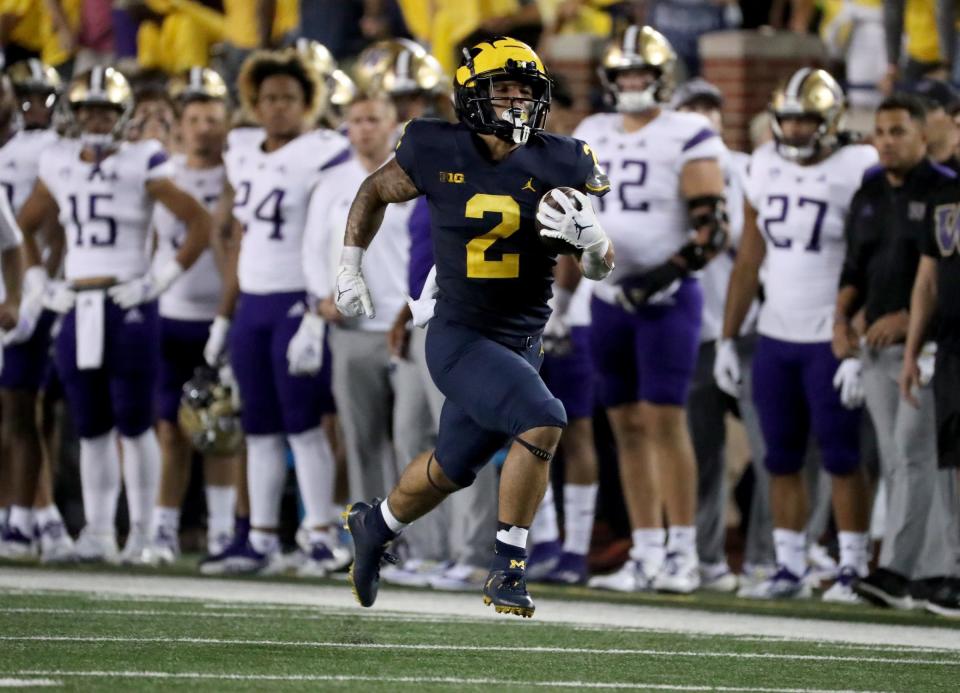Did Jim Harbaugh go old school with Michigan football? Hello 3 yards and a cloud of dust
Free Press writer Rainer Sabin answers three questions after Michigan football defeated Washington, 31-10, Saturday in Ann Arbor.
How did Michigan fill Ronnie Bell’s void?
Last Monday, Jim Harbaugh wore a dour expression as he described the extent of Ronnie Bell’s knee injury and its potential ramifications. After the Michigan coach announced Bell had been lost for the season, he acknowledged the Wolverines would be hard-pressed to fill his void.
SHAWN WINDSOR: Michigan returning to its run-game roots. For now at least, it's totally working
“It's going to be very difficult to replace Ronnie Bell,” Harbaugh said. “Really tough.”
Bell, after all, is a team captain and one of Michigan’s most versatile weapons. He was capable of playing all three receiver positions and he was also the designated punt returner. The hardship he suffered rippled through the roster, affecting multiple sectors.
Harbaugh indicated a collective effort would be required to mitigate the loss of Bell.
But on Saturday, Michigan’s offense was limited with Bell not in the lineup.
Three receivers — Cornelius Johnson, AJ Henning and Mike Sainristil — contributed catches, but together they produced a grand total of 33 yards. The meager output was the direct result of the Wolverines' decision to shelve their passing game. With no viable threat on the outside, Michigan instead resorted to stubbornly running the ball. Blake Corum and Hassan Haskins reprised their roles as the focal points of Michigan’s unbalanced attack — carrying 48 times Saturday
Cade McNamara, meanwhile, continued to perform in a supporting role — throwing only 15 passes, producing seven completions and contributing just 47 yards of total offense.
THEM CHANGES: Michigan football scheme change on 'D' could boost NFL draft stock of key players
Bell’s absence was felt elsewhere. Caden Kolesar, the defensive back who joined the program as a preferred walk-on, continued to handle punts. While he did net a 20-yard return, he appeared a bit gun-shy fielding the ball on other occasions. Earlier in the week, Harbaugh seemed open to using another player as a return specialist — noting Kolesar's value at other spots within the same unit. But it seems safe to say those other options won't deliver the same impact as Bell, who was conspicuous by his absence Saturday.

Did Jim Harbaugh unleash Cade McNamara?
Against Western Michigan, Harbaugh instructed McNamara to manage the game. He did so with ease, completing nine of 11 pass attempts while spearheading scoring drives on six of the seven possessions he directed the offense. But would McNamara continue to operate as a game manager against better competition?
The answer seemed to be delivered in the first half Saturday as Michigan ran a retrograde offense that hearkened back to a bygone era — or maybe just the early days of Harbaugh’s tenure.
The Wolverines ran and ran and ran. Fifty-six times! Rarely did McNamara unleash a pass, throwing 15 of them. Then again, his arm wasn’t needed in a game that devolved into an old-school rock fight, with Michigan controlling the line of scrimmage.
Under the stress applied by Michigan’s potent ground game and operating with little margin for error, Washington’s defense eventually snapped
Never was that more evident than on the first possession of the second half, when McNamara repeatedly shoved the ball into midsection of Haskins and Corum. The two running backs carried Michigan 73 yards for a touchdown, tag-teaming on an eight-play trip to the end zone. Not a single pass was thrown by McNamara, whose role as an accessory in Michigan's offense crystallized under the Big House's bright lights.
What was the decisive point of the game?
If there were one sequence that decided the game, it took place within a three-minute window during the second quarter.
It was here when Washington coach Jimmy Lake opted not to roll the dice with his team and Harbaugh chose to bet on his bunch. It all started on fourth-and-inches at Washington’s 36-yard line. The Huskies had just escaped the shadow of their end zone and showed their first signs of life — picking up a pair of first downs in quick succession. With Washington on the verge of netting yet another one, Lake initially kept his offense on the field. Quarterback Dylan Morris then ran a sneak, lunging across the line to gain. Yet Michigan had called a timeout just before the play began, negating Morris' effort.
Lake then reassessed his options and punted. Michigan fielded the ball at the 21-yard line before running three times to the cusp off the first-down marker. On fourth-and-one at their own 30, the Wolverines lined up in a punt formation. The ball was snapped to the upback, Michael Barrett, who scampered three yards for a first down. Seconds later, Corum raced 75 yards to the end zone to give Michigan a 10-0 lead.
The crowd roared and the Wolverines had regained momentum against a wilting opponent with a feckless offense.
After that, Washington didn’t stand much of a chance.
Contact Rainer Sabin at rsabin@freepress.com. Follow him on Twitter @RainerSabin. Read more on the Michigan Wolverines, Michigan State Spartans and sign up for our Big Ten newsletter.
This article originally appeared on Detroit Free Press: Did Jim Harbaugh go old school with U-M's offense?

